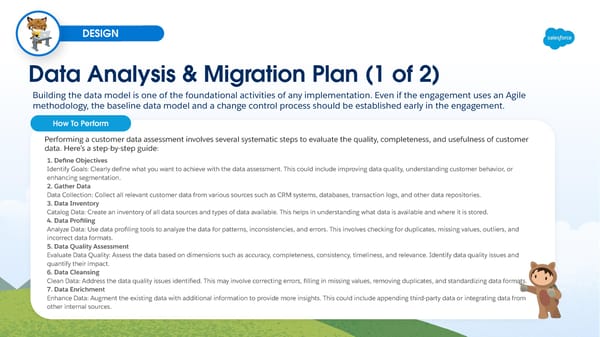2 DESIGN Data Analysis & Migration Plan (1 of 2) Building the data model is one of the foundational activities of any implementation. Even if the engagement uses an Agile methodology, the baseline data model and a change control process should be established early in the engagement. How To Perform Performing a customer data assessment involves several systematic steps to evaluate the quality, completeness, and usefulness of customer data. Here’s a step-by-step guide: 1. Define Objectives Identify Goals: Clearly define what you want to achieve with the data assessment. This could include improving data quality, understanding customer behavior, or enhancing segmentation. 2. Gather Data Data Collection: Collect all relevant customer data from various sources such as CRM systems, databases, transaction logs, and other data repositories. 3. Data Inventory Catalog Data: Create an inventory of all data sources and types of data available. This helps in understanding what data is available and where it is stored. 4. Data Profiling Analyze Data: Use data profiling tools to analyze the data for patterns, inconsistencies, and errors. This involves checking for duplicates, missing values, outliers, and incorrect data formats. 5. Data Quality Assessment Evaluate Data Quality: Assess the data based on dimensions such as accuracy, completeness, consistency, timeliness, and relevance. Identify data quality issues and quantify their impact. 6. Data Cleansing Clean Data: Address the data quality issues identified. This may involve correcting errors, filling in missing values, removing duplicates, and standardizing data formats. 7. Data Enrichment Enhance Data: Augment the existing data with additional information to provide more insights. This could include appending third-party data or integrating data from other internal sources.
 A Partner Readiness Guide to Deliver Like Salesforce Page 60 Page 62
A Partner Readiness Guide to Deliver Like Salesforce Page 60 Page 62